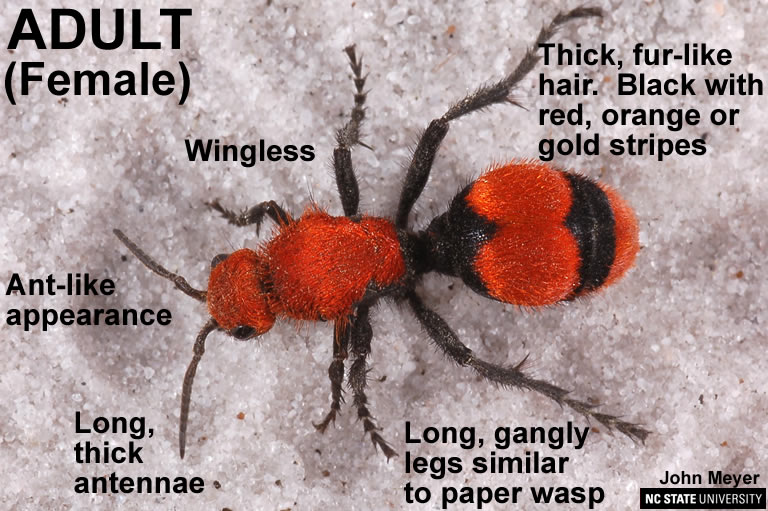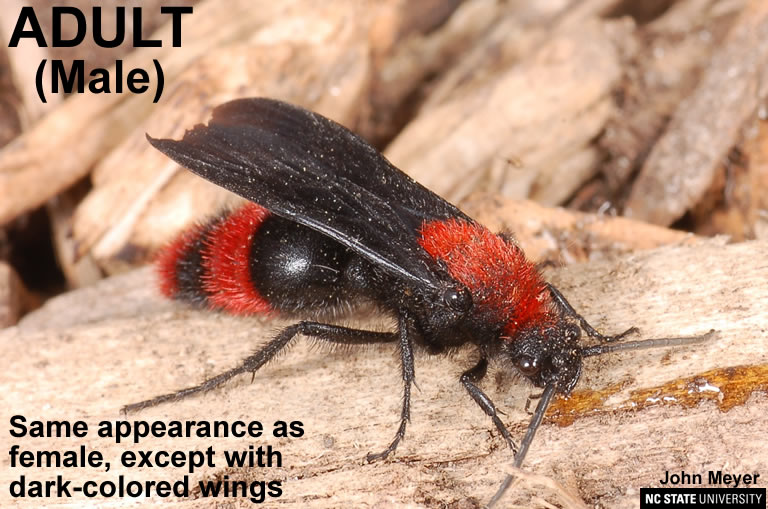Velvet Ant
go.ncsu.edu/readext?563382
en Español / em Português
El inglés es el idioma de control de esta página. En la medida en que haya algún conflicto entre la traducción al inglés y la traducción, el inglés prevalece.
Al hacer clic en el enlace de traducción se activa un servicio de traducción gratuito para convertir la página al español. Al igual que con cualquier traducción por Internet, la conversión no es sensible al contexto y puede que no traduzca el texto en su significado original. NC State Extension no garantiza la exactitud del texto traducido. Por favor, tenga en cuenta que algunas aplicaciones y/o servicios pueden no funcionar como se espera cuando se traducen.
Português
Inglês é o idioma de controle desta página. Na medida que haja algum conflito entre o texto original em Inglês e a tradução, o Inglês prevalece.
Ao clicar no link de tradução, um serviço gratuito de tradução será ativado para converter a página para o Português. Como em qualquer tradução pela internet, a conversão não é sensivel ao contexto e pode não ocorrer a tradução para o significado orginal. O serviço de Extensão da Carolina do Norte (NC State Extension) não garante a exatidão do texto traduzido. Por favor, observe que algumas funções ou serviços podem não funcionar como esperado após a tradução.
English
English is the controlling language of this page. To the extent there is any conflict between the English text and the translation, English controls.
Clicking on the translation link activates a free translation service to convert the page to Spanish. As with any Internet translation, the conversion is not context-sensitive and may not translate the text to its original meaning. NC State Extension does not guarantee the accuracy of the translated text. Please note that some applications and/or services may not function as expected when translated.
Collapse ▲- Common Name: Velvet Ant
- General Category: Parasitoid
- Taxonomic Classification: Hymenoptera: Mutillidae
- Scientific Name: Many species
Description
Velvet ants are actually wasps, but have earned their common name because the females are wingless, have an ant-like appearance, and are covered with a thick almost fur-like coating of hairs. Because of their bright color and size, adult females are often noticed scurrying along the ground in open areas. Males are most easily seen when feeding on nectar-producing flowering plants. Females parasitize larvae and pupae of ground-nesting wasps and bees primarily, but a few species will attack beetles and flies. Velvet ants are actually related to paper wasps, so the females have a stinger with which they can inflict a very painful sting if mishandled. They were given their second common name, cow killer, because of folklore stating the sting was so powerful it could kill a cow.


Identification
Review the images for tips on how to identify these predators.
Adults
Both females and males have a dense fur-like covering of hairs on their bodies. They are usually brightly colored with black and either red, orange or gold stripes. They both have long, gangly legs resembling those of paper wasps. They also have an ant-like appearance. This is particularly true in females because of the lack of wings that means they crawl on the ground. The females have a long stinger that is also used as an ovipositor. These can be quite large insects, up to approximately 3/4 inch in length.
Larvae
Because the grub-like larvae parasitize wasp and bee larvae and pupae in underground nests, they cannot be seen unless a nest is purposely dug up.
Value in Pest Management
Because velvet ants primarily parasitize predatory wasp larvae and bee larvae, they may be detrimental to pest management and pollination if in high numbers. They are not sold commercially.
Origin and Distribution
Native, throughout eastern North America.


